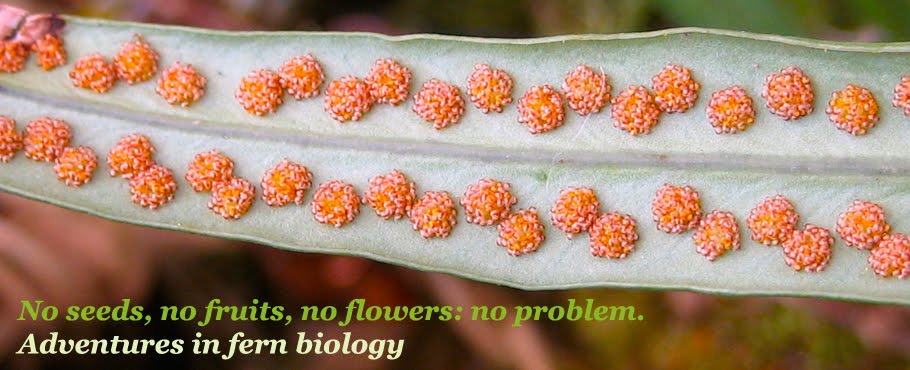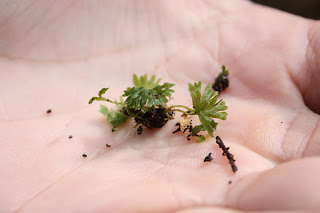Tuesday, November 15, 2011
Winter
Well, we had our first snow of the season here in Madison last week, which means that's probably all for the ferns for this year. The blog will be pretty quiet until the spring, when things start to wake up and there will be fiddleheads to photograph again! There will be big changes for me in the spring, too, as I defend my PhD and graduate from the Botany Department at UW-Madison. You'll hear all about that, and I'm also planning a trip to Arizona in early April, which will hopefully afford some interesting plant stories even while it's still cold in Wisconsin. So please stay tuned for those upcoming posts and any others I can come up with over the cold winter months!
Monday, October 10, 2011
Dryopteris clintoniana
The final species I needed to measure on this trip was Dryopteris clintoniana; after D. ludoviciana it probably has the next-most-limited range of the North American Dryopteris, but happily it grows just a few miles from my beloved Ithaca, NY, so I never mind going out to visit this one. I've followed this population for several years and it's nice to find that it continues to remain stable at the edge of its little swamp. I did notice as I was measuring this year though, that there were a number of plants with, for lack of a better word, weird fronds.
Wednesday, October 5, 2011
Dryopteris ludoviciana
Prior to this last field trip I had only seen Dryopteris ludoviciana in the field once, near Darlington, South Carolina, a couple of years ago, and a major goal of this trip was to find it and measure it. It is the Dryopteris species in North America with the most restricted range, occurring only in the extreme southeast, along the coasts. It is also one of only four diploids involved in the North American reticulate complex, and it is thought to be involved in the parentage, either directly or indirectly, of three of the five allopolyploids in North America. So it was a high priority indeed! Luckily we found a huge, beautiful population of these ferns at the Nature Conservancy's Rocky Hock Swamp Forest Preserve in Hertford, NC, with the help of Raleigh, NC fern enthusiast Jessie Perry. Getting to the plants was no easy feat, and involved a trek across a soybean field followed by hacking our way through a forest - my equipment is many-parted and cumbersome, so in the end I think we were just as glad to be done with these plants as we had been to find them in the first place! It was a great find, though, and I'll remember this population for years to come.
Sunday, September 25, 2011
Hertford, South Carolina
After finishing up my measurements in the greenhouse in Pickens, SC and finding Dryopteris campyloptera in the field, our next stop was eastern North Carolina, in the coastal plain. Our target here was D. ludoviciana, and I'll get to that in the next post, but first I wanted to share some photos of a beautiful cypress bog we happened across on the way back from the D. ludoviciana population.
Beautyberry (Callicarpa sp.) growing near the boardwalk entrance...
Beautyberry (Callicarpa sp.) growing near the boardwalk entrance...
Tuesday, September 20, 2011
Dryopteris campyloptera
The first species I visited in the field on this last trip was Dryopteris campyloptera, which is a tetraploid hybrid between D. intermedia and D. expansa, and which grows at higher elevations in the eastern US. It actually has a disjunct distribution between the Great Smoky mountains and mountains farther north, like the Adirondacks. The southern population is likely a relict that retreated up into the mountains following the last ice ages in the northern hemisphere
I've visited this population before, and it grows in a hemlock dominated forest at Bear Pen Gap turnout on the Blue Ridge Parkway. One of the benefits of working along the Blue Ridge is being treated to views like this:
I've visited this population before, and it grows in a hemlock dominated forest at Bear Pen Gap turnout on the Blue Ridge Parkway. One of the benefits of working along the Blue Ridge is being treated to views like this:
Another neat thing we saw, quite unexpectedly, was this.
What's neat about this, you ask? Look closer...
Thursday, September 8, 2011
Greenhouse
First up in this travel diary of sorts, I have to share these photos of the fantastic greenhouse that Tom Goforth of Crowdog Native Ferns and Gardens set up to house the Dryopteris species used in this study. He built this structure, which has plants in three light levels that were achieved using shade cloth over the roof, and cared for all these plants over the course of the growing season. They had to be regularly watered, randomized and moved around within the treatments, etc. No small task, and I'll be eternally grateful to Tom for all his help with this project (and especially for killing the red wasps that had made a nest over some of the plants in the back of the greenhouse, and for moving two GIGANTIC writing spiders to quarters that wouldn't bring me into contact with them; I'm not a fan of spiders).
Monday, September 5, 2011
Late summer fern fieldwork
After returning from two weeks in Australia this summer, I had about a week's respite at home in Madison before heading out into the field in the US for my last field trip for the ecophysiological portion of my PhD. This three week trek started with a week in Pickens, South Carolina measuring seven Dryopteris species that have been grown and cared for in a greenhouse by my good friend and colleague Tom Goforth of Crowdog Native Ferns and Gardens. We also visited and measured a population of D. campyloptera in the Great Smoky Mountains. Then we drove east to Raleigh and Hertford, North Carolina, where we were led to populations of D. ludoviciana and D. celsa by fern fancier Jessie Perry. I then headed north toward western New York via Norfolk, Virginia, narrowly missing hurricane Irene in the process. In Hamilton and Ithaca I measured the final two species I needed for these studies, and celebrated the end of my PhD fieldwork with friends! The next few posts here will document this whirlwind journey and the plants I encountered along the way. Most will be well known to anyone familiar with this blog, but it's always fun to visit the same species, and in some cases, the same populations, again year after year; many of them have become like old friends to me after five years on this project.
* The photo up top is a hemispheric photograph taken with a special fisheye lens mounted on a regular camera. The photo is taken at about plant height, and can be used to measure the percent of the canopy that is open and affording access to sunlight for the plants; you can also get more sophisticated and use it to figure out the total amount of light a given location under the canopy will receive over the course of the growing season, given is elevation and lat/long. I have used these photos to quantify the light environments of my species, as light is the primary environmental variable whose potential influence on evolution I'm interested in quantifying.
Monday, August 22, 2011
Australian ferns: part III
In keeping with my trend of decreasing in size with these fern posts, this last one focuses on the truly tiny: gametophytes that we found growing on moist soil banks. Gametophytes are the free-living haploid stage of the fern life cycle, and in temperate climates they're usually pretty challenging to locate, since they're small, relatively ephemeral, and look just like mosses. In the tropics it's considerable easier to find them, and as soon as we started to hunt for them they started to pop out of the background. The photo above shows a large clump of gametophytes that may actually a single plant, or a bunch clumped together. That's a bit of moss sticking out of the back, not a sporophyte. The two photos below do show sporophytes starting to grow out of the gametophytes; in the first one the sporophyte is pretty small, and the large, heart-shaped plate-like structure below it is the gametophyte. In the second, the sporophytes are becoming more branched and the gametophyte is harder to make out in all the green, but it's still there!
Wednesday, August 17, 2011
Australian ferns: part II
This second installment on Australian ferns focuses on more diminutive specimens (except for the tree ferns above), including some gorgeous filmy ferns (family Hymenophyllaceae) that we found growing in a probably perpetually-moist splash area around a culvert.
Monday, August 15, 2011
Australia ferns: part I
You may have noticed a distinct lack of ferns in the last few, Australia posts... that's because I've been saving the best for last! We did indeed see lots of ferns Down Under, though unfortunately I know very few of their names. All of these photos were taken in the various eucalypt forests we drove through, and there will be three of these fern-centric posts to round out my series on this summer's Australian adventures.
This is a tree-fern stump that was burned in the recent, awful fires that consumed thousands of acres around Marysville in January 2009. This fern didn't survive, but the vascular structure that remains inside the trunk is beautiful.
Friday, August 12, 2011
Little Desert National Park
Our drive through Victoria culminated with a visit to the Little Desert National Park, which is at the extreme eastern edge of the state, where it borders South Australia. This is the beginning of the outback, and the vegetation is appropriately scruffy, though with beautiful flowering things if you were careful to look for them...
Subscribe to:
Posts (Atom)



























































